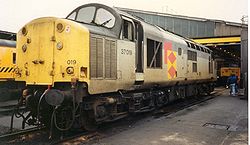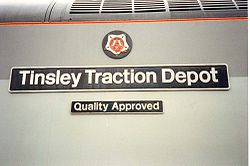
Tinsley Motive Power Depot
Encyclopedia


Traction maintenance depot
In the United Kingdom, a traction maintenance depot, or TMD, is a railway depot where locomotives are serviced and maintained. A traction and rolling stock maintenance depot, or T&RSMD, is a maintenance depot where locomotives, multiple units and rolling stock are serviced and maintained. Each rail...
) was built as part of the Sheffield district rail rationalisation plan of the 1960s
Sheffield district rail rationalisation plan of the 1960s
The Sheffield District Rail Rationalisation Plan was a series of linked railway civil engineering projects, station and line closures and train route changes that took place in and around Sheffield, South Yorkshire...
opening during 1965 and situated adjacent to, but at a higher level than the new Tinsley Marshalling Yard
Tinsley Marshalling Yard
Tinsley Marshalling Yard was a railway marshalling yard located near Tinsley in Sheffield. It was opened in 1965 as a part of a major plan to rationalise all aspects of the rail services in the Sheffield area, and closed in stages from 1985 with the run-down of rail freight in Britain. It was also...
alongside the Sheffield District Railway
Sheffield District Railway
The Sheffield District Railway was a railway line in South Yorkshire, England with its main line running between Brightside Junction, on the Midland Railway's Sheffield to Rotherham line, and Treeton Junction, on the same company's Rotherham to Chesterfield line...
in Tinsley
Tinsley, South Yorkshire
Tinsley is a suburb of northeastern part of Sheffield, South Yorkshire. Its name derives from the Old English Tingas-Leah, which means 'Field of Council'...
, near Sheffield
Sheffield
Sheffield is a city and metropolitan borough of South Yorkshire, England. Its name derives from the River Sheaf, which runs through the city. Historically a part of the West Riding of Yorkshire, and with some of its southern suburbs annexed from Derbyshire, the city has grown from its largely...
but accessed, by road, from Brinsworth, near Rotherham
Rotherham
Rotherham is a town in South Yorkshire, England. It lies on the River Don, at its confluence with the River Rother, between Sheffield and Doncaster. Rotherham, at from Sheffield City Centre, is surrounded by several smaller settlements, which together form the wider Metropolitan Borough of...
.
Diesel locomotives had been stationed at the old steam shed at Grimesthorpe
Grimesthorpe engine shed
Grimesthorpe engine shed was an engine shed in Grimesthorpe, Sheffield. It was built by the Midland Railway and opened in 1860 to serve the Midland Main Line. The shed was built next to Grimesthorpe Junction, the building was a brick roundhouse shed, an eight road fitting shop was added in 1898...
until the new facilities were completed and the locomotives were moved to their new home. The site also included a small electric locomotive servicing shed at the south end of the Secondary Yard, replacing the facilities at Darnall
Darnall engine shed
Darnall engine shed was an engine shed in Darnall, Sheffield. It was built by the London & North Eastern Railway to serve the Sheffield area, passenger trains originating or changing at Sheffield Victoria and goods and pilot workings...
. Diesel railcars, which had been serviced at Darnall, were moved to a new servicing depot adjacent to the "Fish Dock" at the south end of Sheffield Midland station
Sheffield Midland station
Sheffield station, formerly Pond Street and later Sheffield Midland, is a railway station in Sheffield, England and is the busiest station in South Yorkshire...
.
During the sectorisation period of British Rail, the depot came under the control of Railfreight Distribution (RFD).
The sub-sector was responsible for non-trainload freight operations, as well as Freightliner and Intermodal services.
In 1995, as a part of the reorganisation for Privatisation, RFD was required to relinquish some of its class 47s to a new sector; Freightliner.
The following year, EWS bought RFD, mostly for the lucrative Channel Tunnel operations.
Since the Class 47s were considered 'life expired' by EWS management, and there were other depot facilities relatively close by (Toton, Bescot and Doncaster), and the other RFD locomotives were all electrics based at Crewe Electric TMD, the need for the Sheffield depot was deemed unnecessary.
In 1998 the shed closed and by June 2006 the site had been completely cleared for new development and all that remained was the abutments of the rail overbridge used for access.
Allocations
In October 1965 the allocation of motive power to Tinsley depot was as follows:- Class 08British Rail Class 08The British Rail Class 08 is a class of diesel-electric shunting locomotive. From 1953 to 1962, 996 locomotives were produced, making it the most numerous of all British locomotive classes....
: 74 - Class 13British Rail Class 13The British Rail Class 13 were created in 1965 because of a necessity to provide more powerful shunters for the Tinsley Marshalling Yard. This was achieved by permanently coupling together two Class 08 shunters as a 'master and slave' units, the latter with its cab removed...
: 3 - Class 20British Rail Class 20The British Rail Class 20, otherwise known as an English Electric Type 1, is a class of diesel-electric locomotive. In total, 228 locomotives in the class were built by English Electric between 1957 and 1968, the large number being in part because of the failure of other early designs in the same...
: 12 - Class 25British Rail Class 25The British Rail Class 25 diesel locomotives were also known as Sulzer Type 2 and nicknamed Rats, as it was alleged they could be seen everywhere in Britain, and hence were "as common as rats"...
: 11 - Class 31British Rail Class 31The British Rail Class 31 diesel locomotives, also known as the Brush Type 2 and originally as Class 30, were built by Brush Traction from 1957-62.- Description :...
: 57 - Class 37British Rail Class 37The British Rail Class 37 is a diesel-electric locomotive. Also known as the English Electric Type 3, the Class was ordered as part of the British Rail modernisation plan....
: 42 - Class 47British Rail Class 47The British Rail Class 47, is a class of British railway diesel-electric locomotive that was developed in the 1960s by Brush Traction. A total of 512 Class 47s were built at Crewe Works and Brush's Falcon Works, Loughborough between 1962 and 1968, which made them the most numerous class of British...
: 73

